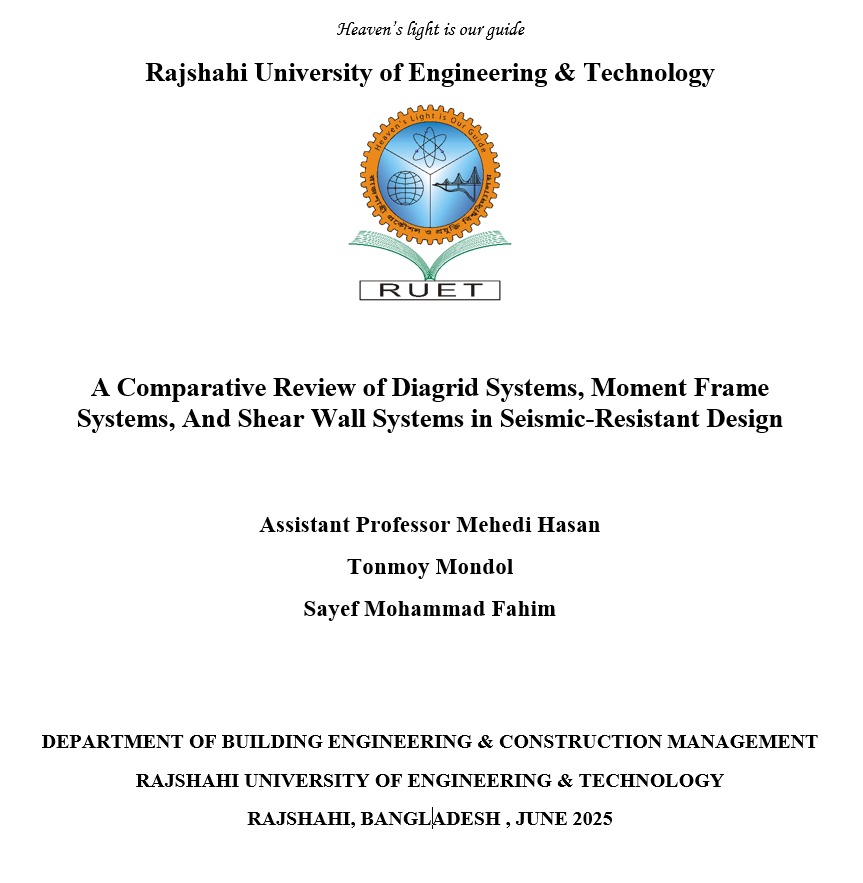
A Comparative Review of Diagrid Systems, Moment Frame Systems, And Shear Wall Systems in Seismic-Resistant Design
Title
A Comparative Review of Diagrid Systems, Moment Frame Systems, And Shear Wall Systems in Seismic-Resistant Design
Author
1. Mehedi Hasan,
Assistant Professor, Rajshahi University of Engineering & Technology, Bangladesh
2. Tonmoy Mondol,
Student, Rajshahi University of Engineering & Technology, Bangladesh
3. Sayef Fahim,
Student, Rajshahi University of Engineering & Technology, Bangladesh
Abstract
Keywords
Conclusion
This comparative review of diagrid, moment
frame and shear wall systems contain the strengths and weaknesses of each
approach in terms of earthquake resistant design. For example, diagrids are
stiffer compared to other systems and offer significant design flexibility, but
they come at a high cost and require complex design practices. On the other
hand, moment frames are known for their ductility and easy of constructability
but they face issues with the joint’s integrity during strong seismic events.
Likewise, Shear walls offer excellent displacement control and stiffness, but
they often require meticulous design details to prevent stress concentrations,
occurs due to their stiffness.
These trade-offs among these systems lead
to the development of hybrid systems. Hybrid systems combine different elements
from these structural systems. For example, integrating base isolations with
diagrids, dampers with moment frames, and energy dissipating devices with shear
walls has been shown to enhance the seismic-performance, cost-efficiency, and
sustainability. Many real-world examples of hybrid solutions around the world
include bamboo-reinforced buildings in Nepal and structures retrofitted with
recycled aggregate concrete in Italy. Also, these structures are tailored to
the local resources, economic conditions, and seismic risks.
Thanks to the advancements of current
technologies such as AI-based design optimization, 3D-printed structural
components, and IoT sensor networks, the design field of earthquake-resistant
structures is evolving significantly. These technological advancements paved
the way for creating more rational and sustainable structures, which can lower
the long-term costs and environmental impacts. However, the real challenge
remains in implementing these advancements, especially in regions with limited
resources.
In conclusion, progress in earthquake-resistant design
depends on selecting the right solutions for the right conditions, fostering
interdisciplinary collaboration, and embracing new technologies and sustainable
approaches. By merging traditional systems with modern technologies and
sustainable practices, designers and engineers can develop secure, robust,
environmentally friendly, and cost-effective structures.
Author Contrubution
The manuscript was written by Assistant Professor Mehedi Hasan, Tonmoy Mondol, and Sayef Mohammad Fahim, who contributed equally to the study, data collection, analysis, and manuscript preparation. Each author played a significant role in the conceptualization and review of the research, ensuring a comprehensive analysis of the structural systems.
Funding
This research was supported by Rajshahi University of Engineering & Technology (RUET), Rajshahi, Bangladesh. No external funding was received for this work.
Conflict of Interest
The authors declare that there is no conflict of interest related to this manuscript.
Data Sharing Statement
The data supporting the findings of this study are available within the manuscript. Additional data will be provided upon reasonable request from the corresponding author.
Software And Tools Use
Acknowledgements
The authors would like to thank their colleagues and classmates at the Department of Building Engineering & Construction Management, Rajshahi University of Engineering & Technology, for their valuable feedback and insights during the preparation of this manuscript.
Corresponding Author
Mehedi Hasan
Rajshahi University of Engineering & Technology, Assistant Professor, Bangladesh
Tonmoy Mondol
Rajshahi University of Engineering & Technology, Student, Bangladesh
Sayef Fahim
Rajshahi University of Engineering & Technology, Student, Bangladesh
Copyright
Copyright: ©2026 Corresponding Author. This is an open access article distributed under the terms of the Creative Commons Attribution License , which permits unrestricted use, distribution, and reproduction in any medium, provided the original author and source are credited.
Hasan, Mehedi, et al. “A Comparative Review of Diagrid Systems, Moment Frame Systems, And Shear Wall Systems in Seismic-Resistant Design.” Scientific Research Journal of Science, Engineering and Technology, vol. 3, no. 1, 2025, pp. 23-39, https://isrdo.org/journal/SRJSET/currentissue/a-comparative-review-of-diagrid-systems-moment-frame-systems-and-shear-wall-systems-in-seismic-resistant-design
Hasan, M., Mondol, T. & Fahim, S.. (2025). A Comparative Review of Diagrid Systems, Moment Frame Systems, And Shear Wall Systems in Seismic-Resistant Design. Scientific Research Journal of Science, Engineering and Technology, 3(1), 23-39. https://isrdo.org/journal/SRJSET/currentissue/a-comparative-review-of-diagrid-systems-moment-frame-systems-and-shear-wall-systems-in-seismic-resistant-design
Hasan Mehedi, Mondol Tonmoy and Fahim Sayef , A Comparative Review of Diagrid Systems, Moment Frame Systems, And Shear Wall Systems in Seismic-Resistant Design, Scientific Research Journal of Science, Engineering and Technology 3, no. 1(2025): 23-39, https://isrdo.org/journal/SRJSET/currentissue/a-comparative-review-of-diagrid-systems-moment-frame-systems-and-shear-wall-systems-in-seismic-resistant-design
7322
Total words2494
Unique Words331
Sentence20.586102719033
Avg Sentence Length0.29098582879021
Subjectivity0.060745043979183
PolarityText Statistics
Viewed / Downloads
Total article views: 57 (including HTML, PDF, and XML)| HTML | XML | Total | |
|---|---|---|---|
| 35 | 8 | 14 | 57 |
Viewed (geographical distribution)
Thereof 57 with geography defined and 0 with unknown origin.